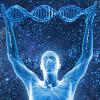SIRT1-dependent restoration of NAD+ homeostasis after increased extracellular NAD+ exposure
Open AccessDOI:https://doi.org/10.1...jbc.2021.100855AbstractIn the last several years, nicotinamide adenine dinucleotide (NAD+) supplementationhas emerged as an innovative and safe therapeutic strategy for a wide spectrum of disorders, including diabetes and neuropathy. However, critical questions remain as to how NAD+ and its precursors are taken up by cells, as well as the effects of long-lasting intracellular NAD+ (iNAD+) increases. Here, we investigated the kinetics of iNAD+ levels in different cell types challenged with prolonged exposure to extracellular NAD+ (eNAD+). Surprisingly, we found that after the initial increase, iNAD+ contents decreased back to control levels (iNAD+ resetting). Focusing our attention on Hela cells, we found that oxygen and adenosine triphosphate (ATP) consumption ocurred with similar temporal kinetics following eNAD+ exposure. Using [3H]NAD+ and [14C]NAD+, we determined that NAD+ resetting was not due to increased dinucleotide extrusion, but rather to reduced uptake of cleaved NAD+ products. Indeed, eNAD+ exposure reduced expression of the ectonucleotidase CD73, the nicotinamide adenine mononucleotide (NMN) transporter Slc12a8, and the nicotinamide riboside kinase NRK1. Interestingly, silencing the NAD+-sensor enzyme SIRT1 prevented eNAD+-dependent transcriptional repression of CD73, Slc12a8, and NRK1, as well as iNAD+ resetting. Our findings provide the first evidence for a SIRT1-mediated homeostatic response aimed at maintaining physiological iNAD+ levels in conditions of excess eNAD+ availability. These data may be of relevance for therapies designed to support the NAD+ metabolome via extracellular supplementation of the dinucleotide or its precursors.
full study at link
https://www.jbc.org/...3RtYWlsLmNvbSJ9
Here is ABS comment on this study
https://alivebyscien...3RtYWlsLmNvbSJ9
They found that iNAD+ levels reached the maximum level after 8 hours of continued exposure, after which those pathways were all downregulated.
Surprisingly, iNAD+ levels returned back to baseline levels at 24 hours, even though eNAD+ levels were still high.
In effect, when given a good supply of eNAD+, cells used all pathways to take in more NAD+. Once iNAD+ was sufficient, pathways for importation of more NAD+ were shut down.
So this study would suggest that supplementing pure NAD+ may actually be beneficial I guess.
Also the study has not date on it? Weird.
Edited by Phoebus, 18 June 2021 - 01:30 PM.































 This topic is locked
This topic is locked




















